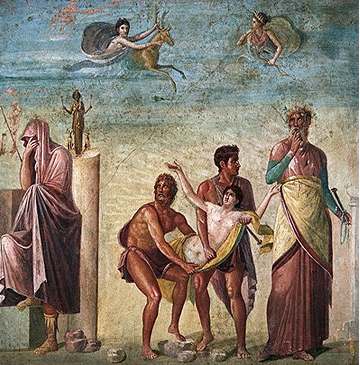October 18, 2004
Sacrifice of Iphigenia
Over 2,000 years ago a young Greek artist named Timanthes studied under a respected tutor. After several years the teacher's efforts seemed to have paid off when Timanthes painted an exquisite work of art. Unfortunately, he became so enraptured with the painting that he spent days gazing at it.
One morning when he arrived to admire his work, he was shocked to find it blotted out with paint. Angry, Timanthes ran to his teacher, who admitted he had destroyed the painting. "I did it for your own good. That painting was retarding your progress. Start again and see if you can do better."
Timanthes took his teacher's advice and produced Sacrifice of Iphigenia, which is regarded as one of the finest paintings of antiquity.
In Myths and Stories of the Trojan War
One of the more unpleasant stories about Agamemnon was that when he had gathered the ships of all the Greek armies at Aulis, ready to sail for Troy, unfavorable winds kept the fleet from departing. Agamemnon had offended the goddess Artemis, and he was told that he could placate the goddess and get favorable winds only if he sacrificed his daughter, Iphigenia. Some variants of the story say he did; some say he didn't. Some say that although he offered Iphigenia as a sacrifice, Artemis took pity and substituted a deer for the girl. Artemis took Iphigenia to Tauris, where she became a priestess. Euripides, a classical Greek playwright, wrote two Iphigenia plays, one about her sacrifice at Aulis, and another about her years in Tauris.
In seventeenth century France, Racine retold the story of Iphigenia at Aulis, modifying the ancient Greek story with neoclassical French sensibility. The Greek army is gathered at Aulis, the winds are unfavorable, Agamemnon is told to sacrifice his daughter. He waffles, saying he will, saying he won't. Ulysses pressures him into doing it, because the army would rebel if he did not. Agamemnon sends a letter to his wife, Clytemnestra, asking her to send Iphigenia to Aulis, where he will marry her to Achilles (who knows nothing of this). Then Agamemnon tries to send another letter, telling them not to come, but it is too late.
Iphigenia arrives and finds out what is in store for her. She is an amazingly dutiful daughter, and is willing to die for her father and the Greek cause. She is taken to be sacrificed, but at the end a messenger comes, saying that she had disappeared from the altar, and been replaced by a deer.

...the picture to which all our accounts refer is the grief exhibited in varying degrees by the bystanders. The countenance of Calchas was sorrowful; that of Ulysses still more so; that of Menelaus displayed an intensity of distress which the painter could not outdo; Agamemnon, therefore, was represented with his face covered by his mantle, his attitude alone suggesting the father's poignant anguish. The description is interesting as illustrating the attention paid in this period to the expression of emotion. Timanthes was in spirit akin to Scopas. There is a Pompeian wall- painting of the sacrifice of Iphigenia, which represents Agamemnon with veiled head and which may be regarded, in that particular at least, as a remote echo of Timanthes's famous picture. F.B. Tarbell A History of Greek Art.
 the painting above is The Sacrifice of Iphigenia, a 1st Century AD Roman copy of a 4th Century BC painting by Timanthes, discovered at Pompeii, and now in the Museum at Naples. Timanthes of Cythnus or Sicyon, a Greek painter of the 4th century BC. Like all other painters none of his works survived. Cicero (Brutus, xviii.70) listed him among the painters who used a four-colour palette. Timanthes defeated with The Sacrifice of Iphigenia Kolotes of Teos in a competition.
the painting above is The Sacrifice of Iphigenia, a 1st Century AD Roman copy of a 4th Century BC painting by Timanthes, discovered at Pompeii, and now in the Museum at Naples. Timanthes of Cythnus or Sicyon, a Greek painter of the 4th century BC. Like all other painters none of his works survived. Cicero (Brutus, xviii.70) listed him among the painters who used a four-colour palette. Timanthes defeated with The Sacrifice of Iphigenia Kolotes of Teos in a competition.
He also defeated Parrhasios in a competition on Samos (Pliny, XXXV.64, 71, 73–4). Parrhasios painting showed Ajax, who according to a story in the Aethiopis and Little Iliad was defeated by Odysseus in the competition for the arms of Achilles. When Timanthes obtained the first prize Parrhasios said that Ajax has suffered a second indignity.
interesting hor??



